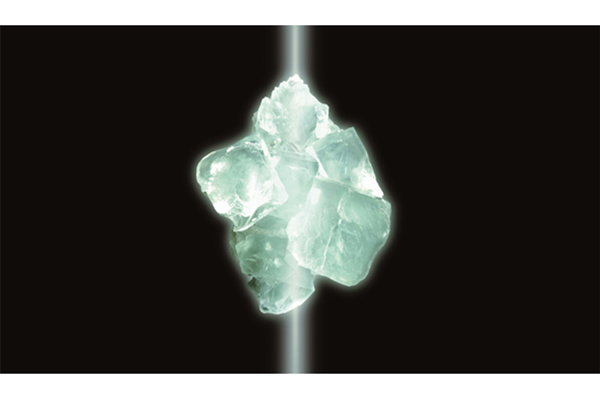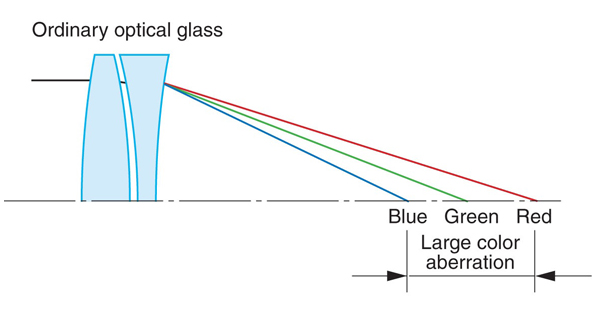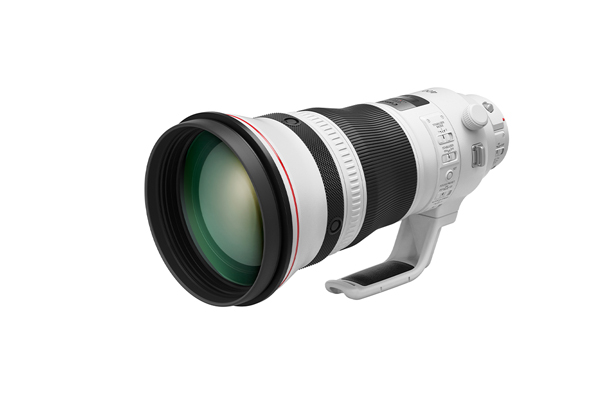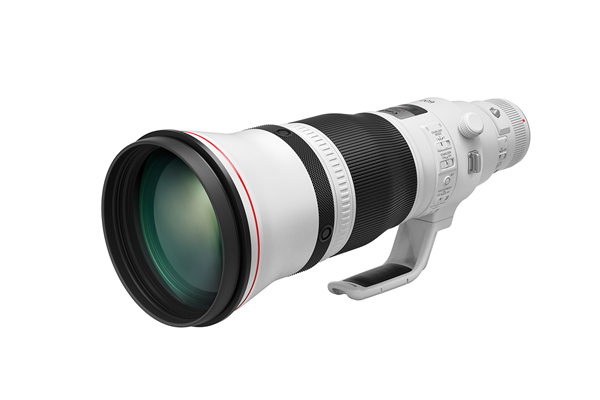News Release
Canon Optron, Inc.
Canon celebrates 50th anniversary of lens employing synthetic fluorite
TOKYO, November 7, 2019—Canon Inc. and Canon Optron, Inc. announced today that this year marks the 50th anniversary of the release of the world's first lens for interchangeable-lens cameras targeting ordinary consumers to employ synthetic fluorite, the FL-F300mm f/5.6 (released in May 1969). Besides lenses for interchangeable-lens cameras, synthetic fluorite is also used in a wide-range of optical products, including broadcast lenses and astronomical telescope lenses.

A synthetic fluorite crystal

The FL-F300mm f/5.6 (released in May 1969), the first Canon ILC lens to employ synthetic fluorite
It has long been known that when combined with optical glass, fluorite, the mineral form of calcium fluoride (CaF2), can correct for chromatic aberration in a manner that is close to ideal. However, naturally occurring fluorite crystals are too small to be of practical use in photographic lenses. In order to realize vivid, subtle rendering not possible with typical optical glass, Canon turned its attention towards effectively harnessing fluorite early on; commencing the Canon F Plan in August 1966 with the aim of developing a high-performance lens that employed fluorite, setting in motion the company's research and development into high-performance lenses.
Around 1950, the technology to synthesize fluorite using naturally occurring fluorite crystals as the raw material was invented, paving the way for its use as an optical material. However, a vacuum environment at temperatures above 1000 degrees Celsius was required to cultivate fluoride crystals, including fluorite, and many issues had to be resolved in such areas as installation and manufacturing process in order to realize the mass production of large-size high-purity crystals.
Canon researchers, fueled by a strong desire to develop fluorite with their own hands towards developing high-performance lenses, succeeded in producing the first fluorite crystals synthesized in an electric furnace in March of 1967, and in February of 1968, established synthetic fluorite crystal production technology. At that point in time, fluorite could not be polished like typical optical glass. Canon developed non-conventional machining technology capable of polishing the delicate material, which took four times as a long. In May 1969, the FL-F300mm f/5.6, Canon's first lens for interchangeable-lens cameras to employ synthetic fluorite, was released. Since then, the use of synthetic fluorite has been one approach for Canon when designing high-performance lenses.
In December 1974, Optron Inc. (now Canon Optron) was established towards commercializing the fluorite crystal mass production technology Canon had cultivated. Canon Optron developed a variety of other optical crystal materials while refining its high-temperature vacuum technologies and temperature control technologies for the mass production of synthetic fluorite. In July 2006, Canon Optron provided 12 lenses to the Smithsonian Astrophysical Observatory, including a synthetic fluorite element with a diameter of almost 40 cm, to be applied to observing signals from over 10 billion light years away, contributing to solving the mysteries of the galaxy.
Canon, will continue to improve its imaging technologies, with a focus on optical technologies, to provide products and technologies that meet the expectations of a wide range of users. Canon continues to pursue the manufacture of appealing, reliable products, playing a part in advancing the optical technologies that contribute to society.
Reference: Characteristics of fluorite
When light meets water or other transparent matter, it is refracted. Lenses are used to take advantage of this property and focus light that passes through them. However, the degree to which light is refracted depends on the color. For example, blue light, which has a short wavelength will be refracted at a steeper angle than red light, which has a long wavelength. For that reason, even light from the same source will be split by color when it passes through a lens and focused on to various different points, leading to the occurrence of color blurring known as "chromatic aberration."

An image captured with a telephoto lens where chromatic aberration can be seen around the edge of the branch in the red square
Chromatic aberration occurs when convex and concave lenses are inversely oriented. It is possible to offset the aberration by combining a small-dispersion convex lens with a high-dispersion concave lens to align the direction of light rays with different wavelengths (such as red and blue) together at the same focal point. However, even with lenses that correct chromatic aberration, if you look closely at the focal point, the intermediate green light between the red and blue wavelengths will still converge at a different point. This chromatic aberration, which remains even after chromatic aberration correction design measures are carried out, is called secondary chromatic aberration, or secondary spectrum. The suppression of this secondary spectrum is where fluorite comes into play.
Compared with optical glass, fluorite lenses have a considerably lower refraction index, low dispersion and extraordinary partial dispersion, and high transmission of infrared and ultraviolet light. Achromatic performance can be achieved by making a convex lens with fluorite, rather than optical glass, to decisively reduce secondary spectrum, causing red, blue and green light rays to almost completely converge on the same focal point to significantly reduce the occurrence of chromatic aberration.


Optical characteristics of optical glass and fluorite
The effects of secondary spectrum are more pronounced for telephoto lenses due to their long focal lengths. To that end, Canon employs fluorite in such contemporary lenses as the EF400mm f/2.8L IS III USM and EF600mm f/4L IS III USM (both released in December 2018). This series of telephoto lenses employing fluorite has earned strong support from photographers worldwide for their subtle rendering and high contrast.
To date, Canon has released 28 EF lens models that employ fluorite lens elements, with 11 of those models still produced. (As of November 7, 2019)

EF400mm f/2.8L IS III USM

EF600mm f/4L IS III USM
EF lenses that employ fluorite
| Product | Release date | No. of Fluorite elements |
|---|---|---|
| EF100-300mm f/5.6L | June 1987* | 1 |
| EF300mm f/2.8L USM | November 1987* | 1 |
| EF50-200mm f/3.5-4.5L | June 1988* | 1 |
| EF600mm f/4L USM | November 1988* | 1 |
| EF500mm f/4.5L USM | March 1992* | 1 |
| EF1200mm f/5.6L USM | July 1993* | 2 |
| EF400mm f/2.8L II USM | March 1996* | 1 |
| EF100-400mm f/4.5-5.6L IS USM | November 1998* | 1 |
| EF300mm f/2.8L IS USM | July 1999* | 1 |
| EF500mm f/4L IS USM | July 1999* | 1 |
| EF400mm f/2.8L IS USM | September 1999* | 1 |
| EF600mm f/4L IS USM | September 1999* | 1 |
| EF70-200mm f/4L USM | September 1999 | 1 |
| EF400mm f/4DO IS USM | December 2001* | 1 |
| EF70-200mm f/4L IS USM | November 2006* | 1 |
| EF200mm f/2L IS USM | April 2008 | 1 |
| EF800mm f/5.6L IS USM | May 2008 | 2 |
| EF70-200mm f/2.8L IS II USM | March 2010* | 1 |
| EF300mm f/2.8L IS II USM | March 2011 | 2 |
| EF400mm f/2.8L IS II USM | August 2011* | 2 |
| EF500mm f/4L IS II USM | May 2012 | 2 |
| EF600mm f/4L IS II USM | May 2012* | 2 |
| EF200-400mm f/4L IS USM EXT1.4X | May 2013 | 1 |
| EF100-400mm f/4.5-5.6L IS II USM | December 2014 | 1 |
| EF70-200mm f/4L IS II USM | June 2018 | 1 |
| EF70-200mm f/2.8L IS III USM | September 2018 | 1 |
| EF400mm f/2.8L IS III USM | December 2018 | 2 |
| EF600mm f/4L IS III USM | December 2018 | 2 |
- *Production finished
